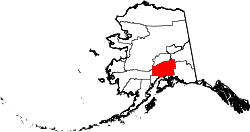Demographics and history
Susitna first appeared on the 1880 U.S. Census as the unincorporated Tinneh villages of Sushetno (combined total of 90 residents, all Tinneh, although they were listed separately as "Sushetno (1st) and (2nd) Villages" (with a population of 44 and 46, respectively). [7] It was not specified which was the present village of Susitna. [8] In 1890, it returned as "Sushitna" (including 2 other villages on Susitna River). All of the residents were Native. [9] It did not return on the 1900 census. In 1910, it returned as Susitna, with a peak population of 233. It returned in 1920 as "Susitna Station."
In 1930, census enumerators returned it as two separate places: "Susitna" and "Susitna Station." It was divided on race, with Susitna Station (population 52), having 51 White residents and 1 Native and Susitna being the "native village", with 39 residents (all native). [10] Depending upon the boundaries of the recording districts (whose maps have not confirmed which side of the 3rd Judicial District they were located within), each was listed in two different districts: Susitna was located in Talkeetna and Susitna Station in Wasilla. This may be erroneous, but further research is needed on the matter.
In 1940, it returned as "Susitna Station" again, with just 12 residents. It did not report again until 1960, when it returned as Susitna. It would not appear again after that until 2000, when Susitna was made a census-designated place (CDP). It was greatly enlarged from its original location on the east bank of the Susitna River to take in both sides of the river, and now the bulk of its area is on the west bank today. [11]
As of the census [12] of 2000, there were 37 people, 19 households, and 6 families residing in the CDP. The population density was 0.2 inhabitants per square mile (0.077/km2). There were 102 housing units at an average density of 0.6 per square mile (0.23/km2). The racial makeup of the CDP was 89.19% white, and 10.81% from two or more races.
There were 19 households, out of which 15.8% had children under the age of 18 living with them, 26.3% were married couples living together, 10.5% had a female householder with no husband present, and 63.2% were non-families. 47.4% of all households were made up of individuals, and 26.3% had someone living alone who was 65 years of age or older. The average household size was 1.95 and the average family size was 3.14.
In the CDP, the population was spread out, with 21.6% under the age of 18, 5.4% from 18 to 24, 24.3% from 25 to 44, 27.0% from 45 to 64, and 21.6% who were 65 years of age or older. The median age was 44 years. For every 100 females, there were 105.6 males. For every 100 females age 18 and over, there were 107.1 males.
The median income for a household in the CDP was $22,500, and the median income for a family was $51,250. Males had a median income of $51,250 versus $0 for females. The per capita income for the CDP was $17,355. There were no families and 16.1% of the population living below the poverty line, none of whom were aged under 18 or over 64.


